#it's the people acting like geese are the villains in their origin story that are my problem
Note
(disclaimer: I am not saying this from a place of hostility to geese)
how did 3-year old you survive feeding geese :( when I was 4 I was feeding ducks and geese (which I was about the same height as at the time) at a local pond and they chased me and tried to bite me until my parents picked me up and ran. I didn't try to scare them and I was a generally quiet child, do I just have Bad Vibes to them or something? or is it something to do with their past experiences/socialization as Pond Ducks/Geese? nowadays whenever a goose or swan so much as starts staring at me I'm like "ok time to go :)"
Without knowing more about the situation, I can't say what particular thing you did, but I can say that geese don't chase people for no reason at all. It's possible you got too close rather than letting them come to you, it's possible you were just plain too close to their nesting site, it's possible you performed a movement that (in goose) suggested your desire to start a dispute. It's possible you were feeding them from your hands and they associated your hands with food, and were simply looking for more food, or attempting to chase you away from the food.
And to be clear, I'm definitely not advocating for people letting small children feed geese, honestly no one should be feeding wild animals, mostly because it familiarizes wildlife with humans and that can be bad, but also because it opens too many opportunities for humans to do the wrong things and end up hurt or scared. As a 4yo, it wasn't your responsibility to know how to interact with geese- it was your parents' job to monitor your actions, the actions and reactions of the geese, and remove you from the situation before it became a problem (or not put you in that position in the first place). The geese are blameless for acting like geese and you are blameless by reason of being 4 years old.
I ALSO want to be clear that being SCARED of something DOES NOT equal HATING something. Hate can stem from fear, and fear can stem from hate, but they are not the same thing. There are PLENTY of people, for example, who are terrified of spiders but who will either remove them from a place with a cup and paper, or fetch someone to do so, to prevent a spider from dying for the crime of being small. You (general) can be afraid of something and still treat it with respect. You do not have to hate the things you are afraid of.
#geese#be afraid of them all you want#it's the people acting like geese are the villains in their origin story that are my problem#asks#anon asks#we always mind our business around waterfowl and other wild birds#I had a group of geese in the street with their babies once#and I needed to leave work to go home#and instead of trying to chase them out of the road#I gave them some of the bird-safe treats in my car and then walks into the grass#and they followed me looking for more#So i tossed some into the grass and left via the now-clear road with no conflict#you just gotta ask them not tell them#and again..... they literally cannot chase you if you don't run#and they're more bark than bite they do not actually want to fight you#unlike swans who DO want to fight you
70 notes
·
View notes
Text
The Aristocats at 34
A review by Adam D. Jaspering
The second Disney Dark Age was defined by a series of decisions resulting in decreased film quality. Some decisions were timesavers, prioritizing efficiency above craft. Some were financial decisions, scaling back ambition, favoring simplicity. Some of it was a general sense of disillusionment. The glory days of the Disney empire were gone. Animation as a medium was in a rut. The prestige of working in cartoons was akin to working on an assembly line.
The Aristocats was never a children’s book, fairy tale, or published story. It was an original concept by writers Tom Rowe and Tom McGowan for Disney’s Wonderful World of Color. In 1961, they were instructed to develop stories featuring animal protagonists.

One of the stories involved a family of cats forced from their home by an evil butler and maid. The cats would hide around Paris, staying safe, exploring the locales, having adventures. This was the first draft of The Aristocats.
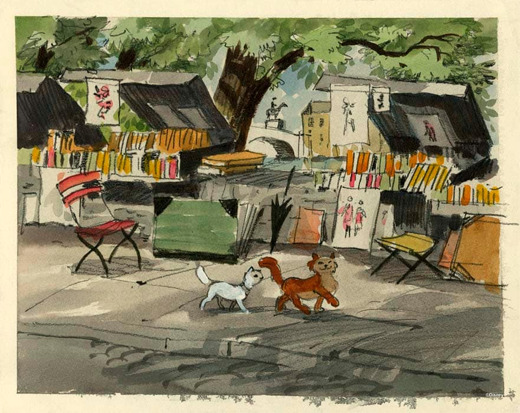
For years, the writers worked and re-worked the story as a two-part, live-action, made-for-TV movie. From every angle, The Aristocats was infeasible. The writers were trapped in an endless cycle of revision, rejection, revision, rejection. By 1966, they gave up. With so much time, money, and effort sunk, they recouped their losses by selling the treatise to Disney Animation Studios.
The animated medium worked to the writers’ advantage. The cats could now talk, react, move, emote, and think like more than simple house pets. It made completing the script much simpler. However, that was the only advantage earned.
The greatest indicator of the troubled writing process is how heavily the movie borrows ideas from previous Disney films. Disney had made films about pets in trouble before, and they were successes. To copy their success, The Aristocats copied a number of plot elements and themes.
Consider what is lifted from 101 Dalmatians. Someone nefarious kidnaps a bunch of beloved pets. The pets evade their captor, and are forced on an arduous trek back home. They find respite only through the hospitality of other animals along the way.

Consider what is lifted from Lady and the Tramp. A spoiled pet, accustomed to love and indoor life, is forced from home. They find a streetwise transient with a heart of gold who agrees to help. Over time, love blooms despite the pair coming from two different worlds.
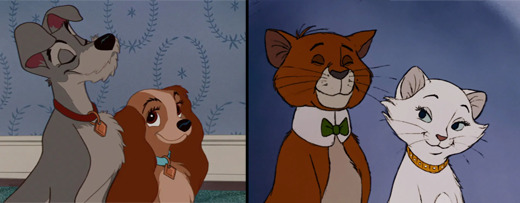
The Aristocats is a shameless blend of 101 Dalmatians and Lady and the Tramp, simply substituting the dogs with cats. It offers nothing unique. What it lifts, it doesn’t improve on.
The xerographic animation is the worst its ever been. Xerography has always resulted in scratches, inconsistent line widths, and rough details. In The Aristocats, it’s laughably bad. Lines are sketchy, frayed, and wiry. In wide shots, character outlines are too thick. On close-ups, outlines are too thin. Errant reference lines are left in place, never cleaned before going to print. Detail lines are too bold and garish. The animators were either getting sloppy or lazy.
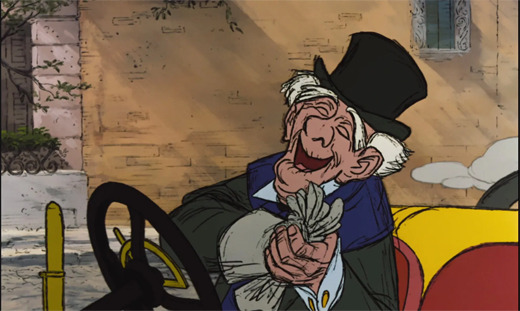
The female lead of the movie is Duchess, a white angora cat. She is voiced by Hollywood actress Eva Gabor. Gabor is best known for the sitcom Green Acres, where she played a socialite unwillingly relocated to a country setting. She admirably plays Duchess, a cat socialite unwillingly relocated to a country setting.
Gabor lends an air of nobility and sophistication to the character. Unfortunately, she never fully hides her Hungarian accent. She slips between her natural voice and a French affectation, creating a definite European sound, but not of any particular area.
Duchess’s three kittens are Marie (white, voiced by Liz English), Berlioz (black, voiced by Dean Clark), and Toulouse (orange, voiced by Gary Dubin). All three are voiced by American children and speak in an American accent.

In most Disney movies, young characters are voiced by actual children. The same is true for The Aristocats. Unfortunately, the three actors here are among the worst the studio has ever seen. The children lack a sense of timing and awareness in their recitations. Everything they say is forced and toneless. They’re not acting, just reciting the script. It’s made all the worse they don’t project, delivering their lines quietly and without passion into the microphone. Every line sounds as though they have sore throats and stuffy noses.
The male lead is O’Malley, an orange piebald shorthair voiced by Phil Harris. Phil Harris voiced Baloo in The Jungle Book, and was acclaimed for bringing the bon vivant bear to life. It’s no surprise, in a film that has already recycled so much, it recycles an entire character. Phil Harris gives O’Malley Baloo’s relaxed nature, cocky arrogance, love of music, and budding paternal instincts. The only difference between O'Malley and Baloo are their species.
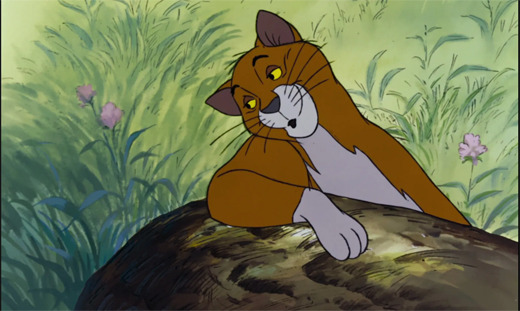
The plot of the film centers around Madame Bonfamille, an elder Frenchwoman of notable wealth. An aging woman, she meets with a lawyer to draft a will. With no spouse and no living family, she bequeaths her estate and all monetary goods to her beloved cats.
This enrages her longtime, long-suffering butler, Edgar. So much so, he conspires to kill the cats, leaving him the sole beneficiary. The evil maid from the original story spec was written out completely.

There is so much to unpack in such a confounding setup. The first among them, Madame Bonfamille won’t relinquish her estate until she dies. She appears to be in her 70s, but is still fully ambulatory, healthy, and mentally sound. She won’t be passing on anytime soon.
So why would Edgar attempt to kill the cats immediately? If he killed the cats now, Madame Bonfamille would adopt new cats and start the cycle anew. Why wouldn’t he kill the cats when Madame Bonfamille is closer to death? If she’s enfeebled or incapacitated, she’d be unable to amend her will.
Let’s give Edgar the benefit of the doubt and assume he panicked. He was blinded by greed. He was offended his boss would discount his years of loyal service. He’s seen as lesser than a quartet of creatures who use a litter box. He didn’t consider the ramifications of preemptive catslaughter. The insult caught him off-guard.

If Edgar behaved rationally, bided his time, and planned a perfect murder, killing the cats would still be stupid. Without researching French estate law of the early 20th century, we can reasonably assume a person cannot name pets as beneficiaries. In which case, the will’s stipulations would be voided and Edgar would inherit the estate.
Assuming it’s unconventional but acceptable, the cats would need a caretaker. What would cats do with such money? Cats can’t shop, can’t pay bills, can’t pay taxes. Edgar would almost certainly be given power of attorney over the cats. He’d live in the manor, be granted a trust fund, and all in exchange for occasionally feeding a few cats. The cats would legally own the wealth, but Edgar would be in charge of where it’s spent. Edgar would get everything anyways, and his hands would be clean.

Even for a kid’s movie, the plot is overly simple and collapses under scrutiny. After so many rewrites and changing of hands, standards dropped noticeably. Nine different writers worked on this movie. The filmmakers had no expectations of the script beyond “complete” and “printed on paper.” The Aristocats is no masterstroke. But maybe it was never intended to be.
It’s never been officially stated, but in an era of financial instability, it’s easy to see the appeal of The Aristocats. A paper-thin plot is an acceptable concession to showcase a bunch of dancing and singing cats.
Disney had never made a cat movie. Disney had made dog movies, and subsequently sold dog toys and dog merchandise. But some people like cats more than dogs. There was an untapped market for cat toys and cat merchandise. All they needed was a cat movie. The plot was irrelevant.
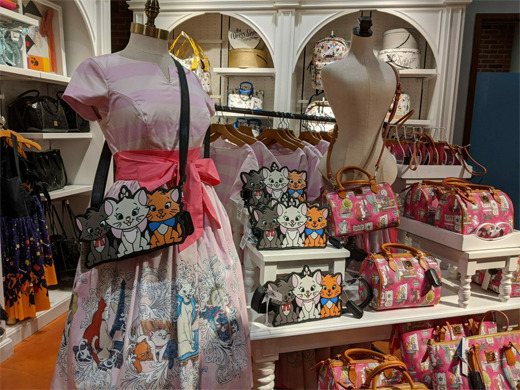
The stakes of the movie are incredibly low. In 101 Dalmatians, the dogs are forced to walk from the outskirts of town back into London. It’s an arduous journey. The weather is harsh and unforgivable. The puppies are tired and hungry. The villain is actively on their trail, ready to attack at any minute.
In The Aristocats, the cats are forced to walk from the outskirts of town back into Paris. It’s a leisurely walk through the countryside. The weather is pleasant and sunny. Edgar doesn’t pursue the cats, assuming them already dead.
The cats were carted off somehow, and now must return home. Their journey isn’t one of survival, just inconvenience. It’s all the tension of a motorist running out of fuel and walking to the nearest gas station.

The plot is so razor thin, characters and vignettes are introduced that do nothing except pad the runtime. After O'Malley falls in a river, he’s saved by a pair geese. It’s an Avis Ex Machina.
Their contribution to the story fulfilled, the geese do not waddle off. The cats follow them into town. There, we meet the geese’s drunken uncle. The drunken uncle does nothing of significance or importance. He stumbles, confused, dizzy, inebriated in a misguided attempt at humor. It’s funny because he abuses intoxicants. Enjoy, kids!
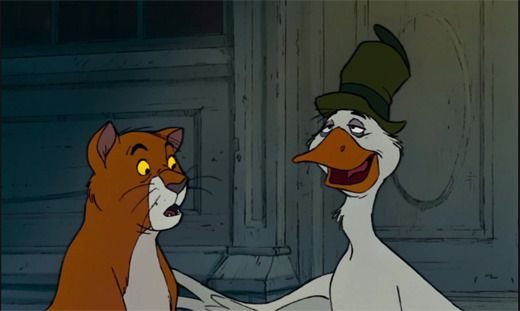
When Edgar attempts to dispose of the cats, his efforts are interrupted by two hound dogs. These dogs chase his motorcycle, causing Edgar to crash. In order to escape without being mauled, Edgar leaves the sidecar and several personal effects behind. He’s forced to return the next day to retrieve the incriminating evidence.
Why these two dogs are so territorial is inexplicable. They don’t just chase Edgar’s motorcycle, they declare a vendetta against him. They chase him off, they chase him back, they even steal the motorcycle and attempt to run him down. If Edgar wasn’t literally trying to drown kittens, the dogs would easily be the villains of the movie.
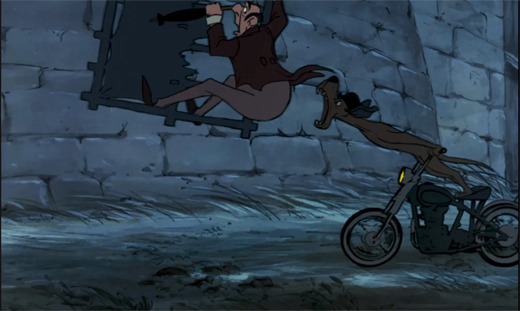
The dogs have Georgia accents. There’s no reason why. They live in France, just the same as any other character. Should we assume the dogs immigrated from the American south just to work on a farm in a new country? Were they adopted by French farmers from breeders across the Atlantic?
Simply put, they’re hound dogs. Hound dogs are stereotypically southern. It would be silly to have them speak French. It’s also silly to have two characters with Georgian accents in the French countryside. There were no good solutions here.

There’s also a Chinese cat who supplants his L’s with R’s when he speaks. He has buck teeth and squinty eyes. He carries chopsticks around with him. The Aristocats copied so much from Lady and the Tramp, why wouldn’t it also copy its racist stereotypes?

Madame Bonfamille and Duchess are the only characters in the film to have French accents. The rest of the characters speak with American, British, and Appalachian accents. For a film set in France, an array of English dialects is distracting and confusing.
Maurice Chevalier sings the film’s title song. Disney secured a French icon, but shied away from the French language. French accents were either too distracting or too indecipherable. At the least, the replacement accents should be consistent.
The French setting was entwined with The Aristocats since its Disney’s Wonderful World of Color days. Producer Harry Tytle is credited with setting the film in Paris. The intention was, what 101 Dalmatians did for London, The Aristocats would do for Paris. Yet another idea borrowed from 101 Dalmatians.
While The Aristocats is set in France, there’s nothing specifically French about its setting. Except for the establishing shots, the movie could just as easily be set in Montreal or Stockholm. Most of the movie is set in a faceless countryside or indistinct buildings.
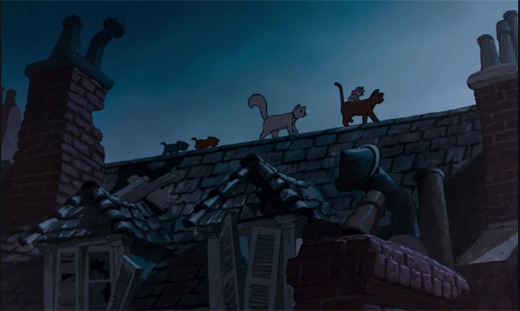
The other puzzling aspect of the setting is when exactly this movie takes place. The movie insists the year is 1910; the vehicles, furniture, clothing, mannerisms, etc support the assertation. But Scat Cat and his crew are cats out of time.
Scat Cat is a jazz musician (voiced by Scatman Crothers, hence the name). Scat Cat and his band are close friends of O'Malley, later becoming friends with Duchess and her kittens. The band play anachronistic, 60s-era swing jazz.
While jazz music did exist in the 1910s, it was closer to its Dixieland and ragtime forbearers. It certainly wasn’t present in France. Jazz didn’t reach French ears until WWI, introduced by American soldiers. All that’s beside the point; Scat Cat and his crew come straight out of the Kennedy era.
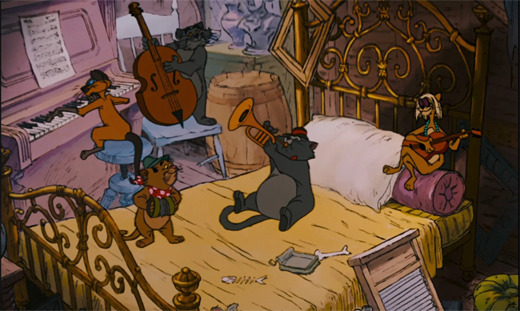
Anachronistic music has never been a problem in Disney films, but early 60s music in a 70s movie set in the 1910s is a disastrous choice. 70s music would be acceptable. 1910s music would be acceptable. Even 40s music, splitting the difference, would be an acceptable choice.
Music can’t be used in a movie just because somebody on staff likes the song. It needs to fit the film, of course, but it also needs to be either modern and contemporary, or a nostalgic throwback. It’s the exact reason the Sherman Brothers shirked from using a rock and roll song in The Jungle Book.
60s jazz is dated, irrelevant, and distracting. It doesn’t belong in the movie. It doesn’t fit the setting. It’s not old enough to be classic, and not new enough to be relevant. It makes Disney seem like their finger is off the pulse. But there were big jazzy numbers in The Jungle Book, and The Jungle Book was a success. So The Aristocats also got a big jazzy number, even if it makes zero sense.

The Aristocats is a mess from the bottom up. The paper thin plot is a discarded treatise no one else wanted to make. It’s puffed up with unnecessary scenes and characters that contribute nothing. What little is offered is blatantly recycled from other Disney pictures. The animation is among the worst ever proffered from Disney Animation Studios. The characters are bland and undefined, the setting is underutilized, and the ending is so conveniently contrived, you can tell precisely when the screenwriters threw their hands up in frustration.
It may be unfair to place the failure of The Aristocats on Disney Studios alone. The 1970s was a dark age for animation in general. The decline of the studio system in the 1960s had a ripple effect into the animation industry. Theatrical shorts from MGM, Warner Bros, Universal, Paramount, and Disney themselves ceased in the mid-60s. Animation was becoming outdated and irrelevant.
The end of the era would be tragic, but animation wasn’t a dead medium. Ironically, the rise of Saturday morning cartoons on television meant animation had a larger audience than ever. But without studio financing and prestige, cartoons were churned out cheaper, quicker, and with smaller returns. There was a market demand without standards or incentive. It was a no-win situation.
Still suffering from Walt’s death years ago, Disney Animation Studios was under financial strains and a creative dry spell. Disney animation was coasting on nostalgia, constantly in danger of being shut down. The board of directors only needed one excuse.
The filmmakers cut every corner and made every concession. In doing so, The Aristocats came in underbudget, and turned a profit. In financial terms, the movie was a success. And while the film has its share of fans and defenders, from a cinematic standpoint, in every other sense, it is a disaster. Disney Studios proved cats don’t always land on their feet.
Fantasia
Snow White and the Seven Dwarfs
Cinderella
Alice in Wonderland
Sleeping Beauty
Pinocchio
The Jungle Book
The Sword in the Stone
Bambi
101 Dalmatians
The Three Caballeros
Lady and the Tramp
Peter Pan
Dumbo
Melody Time
Saludos Amigos
The Adventures of Ichabod and Mr. Toad
The Aristocats
Fun and Fancy Free
Make Mine Music
#The Aristocats#Disney#walt disney#Walt Disney Animation Studios#disney studios#movie review#Film Criticism#film analysis#Disney canon
11 notes
·
View notes
Text
10 Best Fighting Game Movies
https://ift.tt/31CS0wp
Once upon a time, Bruce Lee, Jim Kelly, and John Saxon visited a crime boss’ private island to compete in a fighting tournament and it was awesome. The 1973 movie Enter the Dragon is basically the prototype for the fighting games like Mortal Kombat and Street Fighter. And when those fighting games became popular, they inspired their own movies that either tried to emulate Enter the Dragon or do something completely new.
The ‘90s gave us the cheesy live-action fighting game movies from Hollywood and the animated movies from Japan. There have been several live-action Mortal Kombat movies as well as a few animated ones. There have also been multiple Street Fighter movies, four attempts at Tekken, a trilogy of Fatal Fury films, and more.
Are most of them bad? Yes. But did we pick our 10 favorite fighting game movies anyway? You bet. Here are our picks:
10. ART OF FIGHTING (1993)
Eh…it’s harmless.
The Art of Fighting series is mostly defined by the twist that the first game’s final boss is the main character’s father and the second game’s final boss is a younger incarnation of the villain from Fatal Fury. Take away those aspects and you’re left with a rather lowkey storyline for a fighting game where a teenage girl is kidnapped by a mobster and is rescued by her brother and her boyfriend.
Wait, I said that weird. It’s two different people, I swear! Except in Capcom, where Dan Hibiki is literally both of them merged into one character.
In the 45-minute Art of Fighting movie about Ryo and Robert, who are like chiller and dopier versions of Ryu and Ken, we watch as the duo gets sucked into a plot about stolen diamonds, martial arts criminals, and angry police lieutenants. It doesn’t take itself seriously and it’s a fine, breezy watch.
Ryo’s incorrect hair color kind of irks me, though.
9. STREET FIGHTER ALPHA: THE ANIMATION (1999)
This movie suffers from the same problem as Fatal Fury: The Motion Picture. It features a cast of heroes from a fighting game taking on a villain created for the movie instead of the villains we actually give a shit about. But the movie does also have some brief but awesome cameos (Kim Kaphwan and Geese Howard from Fatal Fury and Dan Hibiki and Akuma from Street Fighter Alpha) to brighten up a less-than-stellar plot.
Street Fighter Alpha: The Animation does at least get by because the original characters play up Ryu’s whole fear about being overcome by “the Dark Hadou.” This leads to some cool animations where Evil Ryu looks like a mindless, shambling zombie but also an unstoppable fighting machine.
The movie’s main storyline is about a kid named Shun who claims that he’s Ryu’s long-lost brother. He too is a fighter cursed with an inner dark side, which is used as a red herring to suggest that Shun’s father (and presumably Ryu’s father) is actually Akuma. That ends up being bupkis and Shun is just linked to some scheme by a mad scientist or whatever.
Probably the funniest thing about this movie is the directors’ infatuation with Chun-Li’s midsection. She’s wearing her form-fitting Street Fighter Alpha costume and there are dozens upon dozens of random close-ups to her lower torso from the front and back. If this were a drinking game, it would kill you.
8. FATAL FURY 2: THE NEW BATTLE (1993)
Of the Fatal Fury movie trilogy, this one is easily the best, even if it makes all the good guys seem like a bunch of overly-serious crybabies. The basic story is that after having avenged his father’s death, Terry hits rock bottom, dusts himself off, and comes out the other end stronger. Good, good. Going Rocky III is the perfect direction for a follow-up.
The problem is that Terry comes off as a bit of a whiner and the other heroes try way too hard to vilify the movie’s main antagonist, who hasn’t actually done anything that terrible. Krauser shows up one day, challenges Terry to a fight, wins, and says, “Okay, when you get better, train and fight me again.” Krauser isn’t trying to take over the world or murder orphans or whatever. He’s just a dude with huge shoulder armor who wants a good fight.
But everyone acts like Krauser’s the absolute worst. Terry starts drinking and falls to pieces while his buddies hope to get revenge. What a bunch of jerks.
While a fun romp, the worst thing about this sequel is how they redesigned Krauser. Gone is his mustache and forehead scar for the sake of making him seem younger. Kind of a bullshit move, considering he’s supposed to be the half-brother to middle-aged Geese Howard.
7. TEKKEN: THE MOTION PICTURE (1998)
This hour-long anime is almost great but just can’t stick the landing. It runs into the same problem as Mortal Kombat: Annihilation where the game series tells a specific overall story but the movie cuts corners to tell the same story. Tekken: The Motion Picture covers the first Tekken while setting up Tekken 3 and skipping Tekken 2 completely.
It means that everything’s well and good until the confusing and rushed finale. Otherwise, the movie is a fine use of the Enter the Dragon formula. Heihachi Mishima has a special island fighting tournament and the entrants include his vengeful son, a couple of cops investigating the situation, a gigantic robot, an angry Native American girl, two feuding assassin sisters, and a bunch of awesome characters who only get about three full frames of appearances each. Really would have liked to see something from Paul, King, and Yoshimitsu, though.
Other than Kazuya being pissed at everything, the best scenes are the over-the-top ones. When Jack does crazy robot stuff, when dinosaurs show up and start eating people, and that memorable sequence where Heihachi catches a hatchet with his mouth and then shatters it with his jaw.
6. STREET FIGHTER (1994)
I know this movie is just a GI Joe script with Street Fighter names pasted over it. I know it’s a cheesefest of dopey ideas and Belgian accents. I’ve long accepted that. Thing is, the movie is still a total blast to watch. What it lacks in faithfulness to the source material, it makes up for with pure camp and ham.
The 16 characters from Super Street Fighter II are represented here, except Fei Long is replaced with the forgettable Captain Sawada. How ironic that the movie star character isn’t even in the movie!
In general, the movie features some head-scratching depictions of classic Street Fighter characters. All-American Guile is played by Jean Claude Van Damme, Charlie Nash and Blanka are the same character, Dee Jay is an evil hacker, Ryu and Ken are comedic conmen, and Dhalsim is a frumpy scientist.
It’s Raul Julia’s M. Bison who keeps this guilty pleasure afloat. He’s to Street Fighter what Frank Langella’s Skeletor was to Masters of the Universe. He gives 110% and his performance is easily the best reason to watch this movie. It’s truly a wonder to behold.
Read more
Games
The Forgotten Fighting Games of the 1990s
By Gavin Jasper
Games
King of Fighters: Ranking All the Characters
By Gavin Jasper
The movie is infamous for inspiring a fighting game based on it, but you know what nobody ever talks about? The Double Dragon movie also had a fighting game based on it made by Technos and released on the Neo Geo. And Double Dragon wasn’t even a one-on-one fighter to begin with!
Anyway, if you intend to sit back and watch Street Fighter, make sure to add in the RiffTrax commentary.
5. DOA: DEAD OR ALIVE (2006)
Enter the Dragon meets Charlie’s Angels is a heck of a concept, but DOA: Dead or Alive is so confidently tongue-in-cheek that it succeeds as an action comedy that’s way better than it has any right to be. Part of why it works is that Dead or Alive has never had much of an overarching storyline, but is more defined by the individual characters (plus, you know, all the cheesecake). Enough of those characters appear in what’s your regular “fighting tournament on a mysterious island” setup.
The whole thing moves with such energy that it’s easy to get sucked in. It’s the opposite of the live-action Tekken movie, where even though the film features accurate versions of all the characters, everything is so drab and lifeless that you just can’t wait for it to be over. In DOA, the combatants spend their downtime playing cartoony action volleyball with Fake Dennis Rodman on commentary, while in Tekken everyone mopes about dystopian capitalism.
Other than Helena’s character being “important dead guy’s daughter,” most of the main characters are charismatic enough to keep your attention during the 3% of the movie when fights aren’t happening. It must suck for Ninja Gaiden fans that Hayabusa is depicted as a total dweeb, but he at least gets to do some cool stuff here and there.
The movie also has Kevin Nash playing a character based on Hollywood Hogan and he’s so likeable that I’m genuinely bummed that he peaces out about halfway into the movie. Luckily, the movie is entertaining enough that I didn’t even notice until after it was over. It helps that during that time, we get more of Eric Roberts, his amazing hair, and his special sunglasses that turn him into the ultimate martial arts master.
Spoiler alert, but the secret to defeating him is, get this, removing his sunglasses!
4. MORTAL KOMBAT LEGENDS: SCORPION’S REVENGE (2020)
It took a while, but Warner Bros. Animation is on fire these days. After that Batman vs. TMNT movie and Teen Titans Go vs. Teen Titans, the studio appears to be hitting more than they miss. That’s exactly the kind of team needed to put together the latest animated Mortal Kombat movie.
This is the umpteenth retelling of the first game’s story. Not only does it have to compete with the first live-action movie, but also the events of Mortal Kombat 9, which depicts the tournament in cutscene format. Fortunately, Scorpion’s Revenge has a few tricks up its sleeve. First, it puts Scorpion in the forefront as the protagonist. He was barely a character in the original movie and the game just had him kill Sub-Zero and feel bad about it for the rest of the story mode. Now he feels like a character in a crossover, making a mark on the original story instead of being put in the sidelines.
We also have the wonderful stunt casting of Joel McHale as Johnny Cage. More importantly, Jennifer Carpenter plays Sonya Blade, which is such a step up from Ronda Rousey’s voice acting in Mortal Kombat 11.
This cartoon has a very hard R when it comes to violence. From the very beginning, Scorpion’s origins are gruesome and grisly. Once Jax is introduced, it doesn’t take long until we realize, “Oh, that’s how they’re dealing with THAT plot point in this continuity.” Then there’s a surprise villain death late in the movie that not only comes as a shocking development, but it’s so graphic and nasty that you can’t help but be taken aback.
Scorpion’s Revenge is a fantastic first chapter of what is hopefully a series of animated movies, but it does have its pacing issues. Scorpion being the protagonist may be a welcome change, but at times it does feel like a square peg being crammed into a round hole.
3. TEKKEN: BLOOD VENGEANCE (2011)
One of the best things about the Tekken series is the endings. While the cutscenes from the first couple games haven’t exactly aged well, these CGI epilogues have become a staple in nearly every installment. What better reward for your time and success than watching a rocking action sequence with Yoshimitsu and Bryan Fury killing each other in the jungle?
And so, to play to the series’ strengths, Bandai Entertainment released a Tekken movie that’s really just one big ending cutscene. It’s not canon, but it feels at home with the games.
Since Tekken’s main conflict is with two ruthless megalomaniacs (Heihachi and Kazuya) and a disgruntled nihilist (Jin), it’s hard to treat any of them as a real protagonist here. Instead, they go with Ling Xiaoyu, who is portrayed as the person who sees the good in Jin and wants him to see the light. She’s given a robotic BFF in Alisa Bosconovitch because Xiaoyu is kind of a tame character and needs someone with chainsaw arms and a jetpack to liven things up.
The first hour or so is good enough to keep your attention and its lightened up by a couple appearances by Tekken’s best character, Lee. But once it gets to the third act, it just becomes a completely awesome Heihachi vs. Kazuya vs. Jin fight, with Xiaoyu taking a backseat to watch all the crazy shit going on. It’s a full-on fireworks factory, as we not only see Devil forms of Kazuya and Jin but a very special final form for Heihachi that’s a true delight for Tekken fans.
2. STREET FIGHTER II: THE ANIMATED MOVIE (1994)
Let it be said that for someone who grew up in the ‘80s and ‘90s, finding a faithful cartoon adaptation of a video game property was not easy. Link and Simon Belmont were unlikable sexual harassers. Mega Man was a more annoying sidekick than Scrappy Doo. Mario and Luigi teamed up with Milli Vanilli. Power Team was…a thing. When we got an animated movie based on Street Fighter II, it was mind-blowing. This was a movie where the very first scene was Ryu tearing Sagat’s chest into a bloody gash thanks to a well-animated Shoryuken.
There’s a lot going on in this movie, but at the same time, nothing is going on. By this point, there were 17 characters in the various Street Fighter II games, and outside of a blink-and-you’ll-miss-it Akuma cameo, it feels the need to include every single one of them. Some get minor roles, like Cammy and Dee Jay. Then there’s Zangief and Blanka, who fight each other for no reason other than for the sake of giving them something to do. Even Ryu vanishes for a huge chunk of the runtime.
Once everything funnels into the third act, this movie is great. And the earlier fight scenes are straight fire too, including the memorable Chun-Li vs. Vega brawl. Even though the movie already feels true to Street Fighter II, it’s even better when you realize that it’s all supposed to be a prequel to the game itself.
Or at least I hope so. Otherwise, all Sagat gets to do is get his ass kicked by Ryu and get chewed out by Bison.
1. MORTAL KOMBAT (1995)
The stars truly aligned for this one. Mortal Kombat Mania was at its peak, so it makes sense that this movie was a retelling of the first game’s story with added aspects from the second game, all while hyping up the arcade release of the third game. CGI was such a novelty in Hollywood in the ’90s that even if it looked primitive, it still looked cutting edge at the time. It was the perfect time to release this movie.
But Mortal Kombat isn’t perfect. Reptile is embarrassing. Scorpion and Sub-Zero being relegated to goons still stings. I still roll my eyes at the part towards the end where Sonya is suddenly the damsel in distress and Raiden flat-out verbally buries her by saying she couldn’t beat Shang Tsung in a million years. Otherwise, it’s the perfect storm of ‘90s action garbage.
There are so many over-the-top and charismatic performances here. Johnny Cage, Raiden, Shang Tsung, Kano, and even Goro are a blast to watch. All 10 characters from the original game are given something to do and, most importantly, they realize how uniquely weird the game’s story is and actually dive headfirst into it. The movie isn’t embarrassed to be a Mortal Kombat movie but handles itself well enough that we aren’t embarrassed to be watching a Mortal Kombat movie.
Even with a PG-13 rating, the movie was violent enough. Kano talked up seeing a pile of frozen guts in the wake of a Sub-Zero fight, Scorpion got his skull sliced apart with demon brain goo spewing all over the place, and Shang Tsung got impaled to death.
With the reboot being rated R, going for the gore could very well be the right route to go, but for the love of the Elder Gods, don’t forget to have FUN. All I’m saying is, if even Johnny Cage isn’t hamming it up, then what’s the point?
The post 10 Best Fighting Game Movies appeared first on Den of Geek.
from Den of Geek https://ift.tt/2Qf5EPa
5 notes
·
View notes